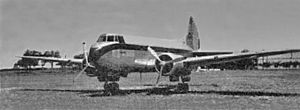The CASA C-202 Halcón was a twin-engine transport aircraft, constructed by CASA.
| C-202 Halcón | |
|---|---|

| |
| Role | transport |
| National origin | Spain |
| Manufacturer | CASA |
| First flight | May 15, 1952 |
| Primary user | Spanish Air Force |
| Number built | 20 |
The Halcón was designed for use on Spain's international air routes. It had tricycle landing gear and a heated/air-conditioned cabin which could accommodate fourteen passengers. Twenty aircraft were initially ordered, and delivered to the Spanish Air Force with the designation T.6.
Operators
editSpecifications (CASA-202)
editData from Jane's All The World's Aircraft 1961–62[1]
General characteristics
- Crew: three
- Capacity: 14 passengers
- Length: 16.0 m (52 ft 6 in)
- Wingspan: 21.58 m (70 ft 10 in)
- Height: 1.85 m (6.06 ft)
- Wing area: 57.50 m2 (618.9 sq ft)
- Aspect ratio: 8.11:1
- Airfoil: NACA 23018 at root, NACA 23009 at tip
- Empty weight: 5,364 kg (11,826 lb)
- Gross weight: 7,750 kg (17,086 lb)
- Fuel capacity: 2,140 L (570 US gal; 470 imp gal)
- Powerplant: 2 × ENMASA Beta B-41 nine-cylinder air-cooled radial engines, 578 kW (775 hp) each (take-off power)
Performance
- Maximum speed: 375 km/h (233 mph, 202 kn) at 2,900 m (9,500 ft)
- Cruise speed: 335 km/h (208 mph, 181 kn)
- Range: 1,210 km (750 mi, 650 nmi) [2]
- Service ceiling: 7,250 m (23,790 ft)
See also
editRelated development
References
editWikimedia Commons has media related to CASA C-202 Halcón.
- Donald, David, ed. (1997). The Encyclopedia of World Aircraft. Prospero Books. p. 222. ISBN 1-85605-375-X.
{{cite encyclopedia}}: Missing or empty|title=(help) - Lambert, C.M. (10 February 1956). "Made In Spain: Part 2–The Work of CASA". Flight. Vol. 69, no. 2455. pp. 169–171.
- Taylor, John W. R. (1961). Jane's All The World's Aircraft 1961–62. London: Sampson Low, Marston & Company.